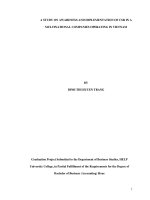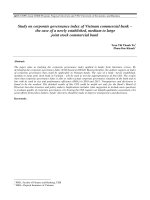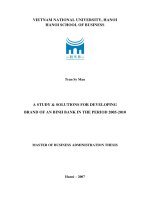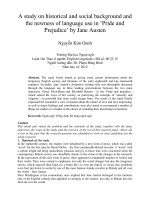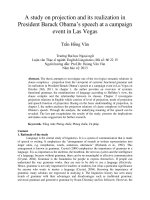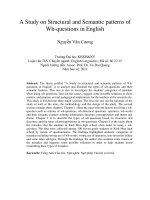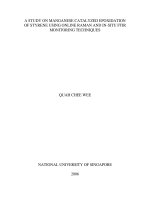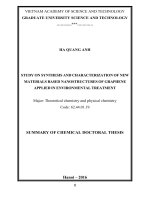A Study on Violation and Flouting of Conversational Maxims in the series “ How I Met Your Mother
Bạn đang xem bản rút gọn của tài liệu. Xem và tải ngay bản đầy đủ của tài liệu tại đây (922.38 KB, 64 trang )
HA NOI PEDAGOGICAL UNIVERSITY 2
FOREIGN LANGUAGES FACULTY
= = == = =
LE THI PHUONG LINH
A STUDY ON VIOLATION AND FLOUTING OF
CONVERSATIONAL MAXIMS IN THE SERIES
“HOW I MET YOUR MOTHER”
(SUBMITTED IN PARTIAL FULFILMENT OF THE REQUIREMENT
OF THE DEGREE OF BACHELOR OF ARTS IN ENGLISH)
HANOI, 2019
HA NOI PEDAGOGICAL UNIVERSITY 2
FOREIGN LANGUAGES FACULTY
= = == = =
LE THI PHUONG LINH
A STUDY ON VIOLATION AND FLOUTING OF
CONVERSATIONAL MAXIMS IN THE SERIES
“HOW I MET YOUR MOTHER”
(SUBMITTED IN PARTIAL FULFILMENT OF THE REQUIREMENT
OF THE DEGREE OF BACHELOR OF ARTS IN ENGLISH)
SUPERVISOR: NGUYEN THI THU THAO, M.A
HANOI, 2019
ii
ACKNOWLEDGEMENTS
To accomplish this study, there was a great amount of contributions from my
dear people around me.
First and foremost, I would like to express my gratitude to all those who gave
me the priceless opportunity to fulfill the study. I want to thank Foreign Languages
Faculty of Hanoi Pedagogical University 2 for granting me permission to conduct
the study. Also, the teaching and guiding of lecturers in four years did provide me
useful background knowledge of language and motivation to do this research.
I want to give my special thank to my supervisor, Ms Nguyen Thi Thu Thao,
whose support and advices did encourage me so much in all stages of doing this
research. Moreover, her helpful suggestions and
straightly critic and careful
comments played a vital role in completing of the study.
Last but not least, I am so appreciated my best friends, Kien, Giang, Hien,
Phuong, Thuy and Nhan. We have been together for almost four years, so we
always support each other to learn and discover new things day by day. To make the
decision of doing the research, I owe them many encouragements and sharing.
Date submitted: 10th May, 2019
Student
Le Thi Phuong Linh
iii
STATE OF AUTHORSHIP
Title: An Study on Violation and Flouting of Conversational
Maxims in the series “ How I Met Your Mother”
I hereby certify that no part of this research has been copied from any
other person’s work without acknowledgements and the study is originally
written by me under the guidance of my supervisor.
Date submitted: 10th May, 2019
Student
Le Thi Phuong Linh
iv
ABSTRACT
This research aims to describe the types of maxims that are violated and
flouted and explain the functions of the non-observation of the four maxims by the
main characters in the sitcom “How I Met Your Mother”. The violations of maxims
occur when the speakers consciously manipulated the maxims so as to mislead the
interlocutors. While the flouting of maxims happens when individuals intentionally
do not observe the maxims since they want to derive the hidden meaning behind to
the listeners, that is, the speakers employ implicature. In obtaining the data, the
researcher uses the non-participant observation to the utterances of main characters
in the season 2 of the series. There are two results of this research. The first result
reveals that the participants mostly did the violation than flouting. From the overall
of non-observations they have done, the quality maxim violation is in the highest
rank and the maxim of relation is flouted most. The second result is that the maxim
violation has four functions namely representatives, declaratives, expressives,
directives and the functions of maxim flouting are representatives, directives,
expressives. Based on the analysis, it showed that there is a connection between the
most dominant violated/flouted maxim with the mostly used function in the
characters’ utterances. For further research, it is suggested that the study will be
conducted in a larger scope of population.
Keywords: Cooperative Principles, maxims, flouting, violation, functions,
How I Met Your Mother (abbreviated to HIMYM)
v
LIST OF FIGURES AND TABLES
Figure 1. The percentage of each violated maxim .................................................... 16
Figure 2. The percentage of each flouted maxim...................................................... 18
Table 1: The frequency of maxim violation .........................................................................15
Table 2: The frequency of maxim flouting ...........................................................................17
Table 3. The functions of maxim violation ...........................................................................19
Table 4. The functions of maxim flouting ............................................................................20
vi
TABLE OF CONTENTS
CHAPTER 1 ................................................................................................................1
INTRODUCTION .......................................................................................................1
1.1. Background of the study ......................................................................................1
1.2. Significances of the study ....................................................................................3
1.3. Aims of the study .................................................................................................3
1.4. Research questions ...............................................................................................3
1.5. Scope of the study ................................................................................................3
1.6. Organization of the study .....................................................................................4
1.7. The sitcom “How I Met Your Mother” ................................................................4
1.7.1. Population .........................................................................................................4
1.7.2. Main Characters ................................................................................................4
1.7.3. A summary of season 2 .....................................................................................6
CHAPTER 2 ................................................................................................................7
LITERATURE REVIEW............................................................................................7
2.1. Theoretical background ........................................................................................7
2.1.1. Conversational implicature ...............................................................................7
2.1.2. Grice’s theory of implicature ............................................................................7
2.1.3. Observance and Non-observance of Grice’s maxims .......................................8
2.1.4. The violation of Grice’s maxims ......................................................................9
2.1.5. The flouting of Grice’s maxims ........................................................................9
2.1.6. Speech acts ......................................................................................................10
2.1.6.1. Declarations..................................................................................................11
2.1.6.2. Representatives ............................................................................................11
2.1.6.3. Expressives ...................................................................................................11
2.1.6.5. Commissives ................................................................................................12
2.2. A review of related studies ................................................................................12
CHAPTER 3 ..............................................................................................................13
vii
METHODOLOGY ....................................................................................................13
3.1. The source of data ..............................................................................................13
3.2. Data collection methods and procedures ...........................................................13
3.3. Data analysis methods and procedures ..............................................................13
CHAPTER 4 ..............................................................................................................15
FINDINGS AND DISCUSSION ..............................................................................15
4.1. Findings ..............................................................................................................15
4.1.1.
Research Question 1: Which conversational maxims are violated/flouted
by the main characters? .............................................................................................15
4.1.1.1. Which conversational maxims are violated by the main characters? ..........15
4.1.1.2. Which conversational maxims are flouted by the main characters? ............16
4.1.2. Research Question 2: What are the functions of maxim(s) violation/flouting
conveyed by the main characters?.............................................................................18
4.1.2.1 What are the functions of maxim violation? .................................................18
4.1.2.2. What are the functions of maxim flouting? .................................................19
4.2. Discussion ..........................................................................................................21
4.2.1. The types of maxim violation in the season 2 of HIMYM series. ..................21
4.2.1.1.
The violation of quality maxim ................................................................21
4.2.1.2.
The violation of manner maxim ...............................................................22
4.2.1.3. The violation of multi-maxim ......................................................................23
4.2.2. The types of maxim flouting in the season 2 of HIMYM series. ..................24
4.2.2.1. The flouting of quantity maxim ...................................................................24
4.2.2.2. The flouting of quality maxim .....................................................................24
4.2.2.3. The flouting of relation maxim ....................................................................25
4.2.2.4. The flouting of manner maxim ..................................................................26
4.3.
The functions of maxim violation and flouting in the HIMYM series. .........27
4.3.1. Representatives ...............................................................................................27
4.3.2. Expressives ......................................................................................................29
4.3.3. Directives ........................................................................................................30
4.3.4. Declarations .....................................................................................................31
CHAPTER 5 ..............................................................................................................34
viii
CONCLUSIONS .......................................................................................................34
5.1. Conclusions ........................................................................................................34
5.2. Limitations of the study .....................................................................................35
5.3. Recommendations ..............................................................................................35
5.3.1. To students ......................................................................................................35
5.3.2. To English language teachers..........................................................................35
5.3.3. To researchers .................................................................................................36
REFERENCE ............................................................................................................37
APPENDIX ...............................................................................................................38
ix
CHAPTER 1
INTRODUCTION
1.1. Background of the study
In the past few decades, English has become the most commonly used
language in the globalized world where people of different cultures use it to interact
and communicate with each other. Communication in society happens chiefly by
means of language. However, the users of language, as social beings, communicate
and use language on society’s premises; society controls their access to the
linguistic and communicative means (Mey, 2005). To conduct a good conversation,
both interlocutors should be active in the interaction. In other words, the speaker
and listener have cooperative behaviors while they are communicating with each
other.
Pragmatics studies the use of language in human communication as
determined by the conditions of society. Pragmatics is a field of knowledge that
makes people know how to appropriately achieve the mutual comprehension, and
politely face the challenges, which are caused by the miscommunication and
misunderstanding in international situations (Kasper, 1997). In fact, people coming
from different places attempt to accomplish the appropriateness in English as a
foreign language. Thus, in order to make an efficient and effective conversation
with others from different areas, they (including both native and non-active English
speakers) should be taught with pragmatics.
Also, Crystal (1997) emphasizes the close relation between pragmatics
competence and English proficiency in his study:” Pragmatics is the study of
language form and the point of view of users, especially of the choices they make,
the constraints they encounter in using language in social interaction, and the effects
their use of language has on other participants in the act of communication”. It can
be said that pragmatics is a socio-cultural context study in intercultural
communication, which is contributed not only from the speakers in saying
utterances but also from the hearers in understanding the utterances from their
opinions. Also the contributions of interlocutors, contexts of utterances such as
physical, social, linguistic contexts and the meaning of potential utterances are
taken into account in producing meaning. In this case, the study will only focus on
researching the meaning of potential utterances in conversations.
1
In the pragmatic field, it looks beyond the literal meaning of an utterance and
considers how meaning is constructed as well as focusing on implied meanings.
Something which is more than the words mean is called an implicature which
means the additional conveyed meaning of utterances (Yule, 1996). It is necessary
to note that when communicating with each other, speakers communicate meaning
via implicatures and listeners recognize those communicated meanings via
inferences. It is selected inferences which will preserve the assumption of
cooperation. Implicatures occuring in conversations and depending on the certain
context for their interpretation are usually called conversational implicatures. As
implicatures are primary examples of more being communicated than is said, so to
obtain a satisfactory account of implicature, communicators should appeal to
cooperative principle in pragmatics.
The philosopher Grice (1975) suggested some rules to have cooperative
behaviors while communicating, interlocutors should follow the Cooperative
Principle which explains how people can be informative, truthful, relevant and clear
in the conversation. The Cooperative Principle comprises four maxims namely
quality, quantity, relation, manner. It means that both the speaker and listener are
expected to follow the cooperative principle to keep smooth and effective
communications’ process.
However, in the real context, not all people tend to observe the maxims to
create more effects of meaning in their utterances. In other words, the speakers
sometimes deliberately break the Grice’s theory to refer their intentions to the
hearers for implying certain reasons. As a social creature, people always
communicate and interact with each other in the form of conversations to express
the idea or convey the emotion depending on the physical environment. Therefore,
to deeply understand the way participants fail to observe the Grice’s theory,
researchers ought to put each conversation in its context.
With some non-native English learners, it seems hard for them to collect the
sources of authentic materials. However, nowadays, the trend of film industry is to
make the artworks become more closer with daily lives. Every situation or event is
cleverly mentioned in each scene, so movies are alike lively pictures of every
person’s life in diverse situations. The sitcom “HIMYM” is considered as an
outstanding example. The situations happening around the main characters might be
so familiar, but with the unique storytelling, it did bring audiences not only
2
eccentric laugh but also meaningful lessons to lives. The main characters in the
HIMYM series do not always observe the Grice’s maxims. In communicating with
others, the main characters do interaction which is not in accordance with maxims
in different situations. If learners study about pragmatics’ theory, by analyzing
social interactions in the series, they will feel more interested. Moreover, it will be
one of the additional references in the field of pragmatic and discourse studies,
which helps to affect the perception of language learners. especially in this case is
English learners’.
1.2. Significances of the study
The study is significantly conducted with functions. Theoretically, it is
expected to provide deeper knowledge as an additional reference for learning in the
pragmatic field, especially the Grice’s theory about the observance and nonobservance of Cooperative Principle and Speech Acts. In additon, this study is
employed to help the teachers to guide their students on Grice’s cooperative
principles through authentic materials and help other researchers in doing similar
projects.
1.3. Aims of the study
This study is aimed at examining how the characters in HIMYM series
violated and flouted the maxims for achieving the functions of that non- observance
of Grice’s maxims.
1.4. Research questions
The aims in this study are to investigate the non-cooperative interactions by
the violation and flouting maxims of the main characters and the functions of the
non-observance of them. In specific, it is aimed at identifying two main questions:
Q1.Which conversational maxims are violated/flouted by the main characters?
Q2.What are the functions of the maxim of violation/flouting conveyed by the main
characters ?
1.5. Scope of the study
The study concerns with a small unit of pragmatics, namely the Cooperative
Principle. The writer only focuses on the main characters’ conversation which
contains the violated and flouted maxims. In the study, the writer uses Grice’s
theory of conversational maxims to analyze the conversation. Additionally, the
3
writer wants to figure out the functions of maxim non-observance when the main
characters violated and flouted the maxims. The limitation is in terms of utterances
conveyed by the character in the season 2 of the HIMYM series which contains the
violation and flouting of maxims and it is used as the data of this study.
1.6. Organization of the study
The writer organizes the study in following order. The first chapter is the
introduction. Chapter two is review of related literature in which the write
describes his background knowledge related to the study. Next, chapter three is
methodology including methods to collect and analyse the data for answering
research questions. Chapter four is final results and detailed discussions about the
research subjects. Finally, chapter five, conclusion, summaries all of the study from
the beginning up to ending.
1.7. The sitcom “How I Met Your Mother”
1.7.1. Population
How I Met Your Mother (abbreviated to HIMYM) is an American situation
comedy that originally aired on CBS from September 19, 2005 to March 31, 2014.
The series is set around the main character, Ted Mosby, and his group of best friend
including the long-lasting couple Lily and Marshall, Robin and Barney in New
York City’s Manhattan. The sitcom simply starts with the scene in which Ted is
recounting to his son and daughter the events that had him meet their mother in the
year of 2030. Famous for its unique plot, eccentric humor, and incorporation of
dramatic elements, HIMYM has become the legendary American series which have
gained a cult following over the years. The sitcom was won 10 Emmy Awards out
of 30 nominations. In 2010, Alyson Hannigan won the People's Choice Award for
Favorite TV Comedy Actress. In 2012, seven years after its premiere, the series
won the People's Choice Award for Favorite Network TV Comedy, and Neil Patrick
Harris won the award for Favorite TV Comedy Actor.
With its reputation through years, the study of this series in terms of
language theory may become easier both for the research conductors and language
learners.
1.7.2. Main Characters
The series concerns the adventures of Ted Mosby (played by Josh Radnor)
narrating the story of how he met the mother of his children. The story is in 2005
4
with Ted Mosby who is living and working as an architect in New York City.
Together with him, his gang of best friends, including the long-lasting couple
Marshall Eriksen (Jason Segel) and Lily Aldrin (Alyson Hannigan), womanizingplayboy Barney Stinson (Neil Patrick Harris), and the news reporter Robin
Scherbatsky (Cobie Smulders) are main parts who contribute to the remarkable
success of the sitcom.
Ted Mosby is a good guy who is an ideal husband of every woman. From
the beginning of the series, Ted is on a quest for happiness and “the one” who he
will marry and live with forever. On the way of finding his true love, he is in
relationship with many women, one of them is Robin, who reveals a lot of
personalities he wishes in his future wife. Despite the failure of finding “the one”
after many times, he still does not give up. Besides, he also acts immaturely when
playing trick with Barney and Marshall.
Marshall Eriksen is the best buddy of Ted Mosby, they are roommates from
the first year at university, Wesleyan University, and remain living with each other
when moving to New York City. Marshall has a beautiful love story with his
girlfriend since his freshman year, Lily. They get married in season 2 and have kids
in season 7. He indulges in the paranormal phenomenon, and mythical creatures,
particularly Sasquatch. His dream is to become an environmental lawyer, which
conflicts with his immediate demands for money, such as for his wedding and to
raise his children.
Robin Scherbatsky is a TV reporter who emigrated from Canada to take a
job in a news station. She additionally met Ted at MacLaren's. She is a strong girl
with some man-like hobbies such as often drinking scotch, smoking cigars, loving
the gun. Moreovers, she really loves career and has strong rejection to the
traditional women’s roles such as marrying and having kids.
Barney Stinson is also a Ted's friend, often jealous of Marshall for having
known Ted since college and the fact of Marshall is Ted's first best friend. He is
really a womanizing playboy who always uses his money and outrageous strategies
to seduce women with no intention of engaging in a long relationship. However, he
is a kind-hearted and generous person to his friends. He also makes the gang laugh
so much because of his jokes.
5
Lily Aldrin is Marshall’s wife. She works as a kindergarten teacher, and an
aspiring artist. Though she is terrible at keeping secrets and can be manipulative at
times, Lily is so sweet and sincere. Lily Aldrin’s best girlfriend is Robin.
1.7.3. A summary of season 2
The summer of 2006 is both wonderful and awful. Ted finally gets together
with Robin, but Lily breaks up with Marshall just before the wedding comes for
chasing her real dream in San Francisco. Because of Lily’s fallout, Marshall seems
to be another person who always stays at home, cry and remember his fiance. After
enduring numerous emotional breakdowns, the gang decide to step in his problem,
Barney tries to get Marshall back to the dating game. After a time, Marshall
becomes Barney’s new ‘wingman’ as Ted is now in a serious relationship with
Robin. Marshal also follows Barney’s advice to impress women, but mostly fails.
Later, Lily, after finally realizing she is not meant to be an artist, returns to New
York. They remain separated since Marshall starts to date another girl, described by
the gang as having 'crazy eyes'. The date with the girl does not end well and
eventually Lily and Marshall become reunited, and their engagement happily
resumes.
The second story is Robin’s aversion to mall which piques the gang’s interest
as to what secret she is hiding. Marshall suspects she is married, and Barney
suspects she has performed in adult films. They bet on it, appointing Lily as "Slap
Bet Commissioner”. Lily oversees the search for the truth, as they discover that
Robin was a teenage pop star named "Robin Sparkles", and Marshall eventually
earns the right to slap Barney five times whenever he wishes.
The third one is the truth about Barney’s father. From his childhood, Barney
and his gay African American half-brother always was told that their father was
Bob Barker, the famous MC of the show The Price Is Right. Thus, Barney comes to
that show to meet his father. He becomes a contestant, wins all the prizes, and gives
to Lily and Marshall as the early wedding gifts.
In the season finale, Ted and Robin have decided to break up with each other
due to their conflicting views on marriage and children. They planned to tell anyone
after the party so as to avoid taking attention away from Lily and Marshall's
wedding, but Barney by accident knows that secret. The season ends when Barney
is excited about being an unfettered single man with Ted again.
6
CHAPTER 2
LITERATURE REVIEW
2.1. Theoretical background
2.1.1. Conversational implicature
The notion of implicature is one of single most important ideas in pragmatics
(Levison, 1983). There are two main kinds of implicature, conversational and
conventional implicature. To concentrate in the objective of language researching in
conversations, this study will often refer to conversational implicature. A
conversational implicature is something which is implied in conversation, that is,
something which is left implicit in actual language use (Mey, 2005). In everyday
talk, the speakers convey propositions that are not explicit in our utterances but are
merely implied by them. Sometimes, the speakers are able to draw such inferences
only by referring what has been explicitly said to some conversational implicature
(Blimes, 1986). Having said that, conversational implicatures are primary examples
of more being communicated than is said, so in order to be interpreted, there are
some basic cooperative principle which are put forward in operation.
2.1.2. Grice’s theory of implicature
The philosopher Grice proposed that cooperation has itself been elevated to
the status of an independent principle. Grice developed the concept of implicature
in his theory with a view to formulate some basic considerations as guidelines for
the efficient and effective use of language in conversation. Grice identified the
guidelines including four pragmatic sub principles, or maxims of conversation,
which jointly express a general Cooperative Principle. The Cooperative Principles is
expressed as follows:
The maxim of quantity:
1. Make your contribution as informative as required;
2. Do not make your contribution more informative than required
The maxim of quality:
1. Do not say what you believe to be false
2. Do not say that for which you lack adequate evidence.
The maxim of relation
7
Make your contribution relevant.
The maxim of manner
Be perspicuous
1. avoid obscurity
2. avoid ambiguity
3. be brief
4. be orderly
These four maxims can be seen as instances of one superordinate Cooperative
Principle : Make your conversational contribution such as is required, at the stage at
which it occurs, by the accepted purpose or direction of the talk exchange in which
you are engaged (Grice, 1975).
2.1.3. Observance and Non-observance of Grice’s maxims
Daily communication is very complicated, people seem to draw inferences in
the words to convey their own ideas. Thus, there are at least two distinct ways that
the inferences come about, which depending on the relation the speakers take to
have towards the maxims. If the speaker observes the maxims in a direct way, he
will answer to the listener by some straightforward inferences based on the
assumption that the speaker is following the maxims. Another way is when the
speaker deliberately does not observe a maxim which inferences are generated.
Grice distinguished five types by which the speaker fails to observe a maxim:
violating, flouting, infringing, opting out, and suspending. In this study, the writer
will only focus on analyzing two kinds of them, violating and flouting the maxims
in the conversations of the main characters in HIMYM series.
It is important to recognize these maxims as unstated assumptions in
conversations. When communicating, people assume that their interlocutors are
normally going to provide an appropriate amount of information which is true, clear
and relevant because these principles are assumed in normal interaction, this study
will not mention to them. However, in reality, some circumstances where speakers
may not follow the expectations of cooperative principle. In other words, the
participants are not going to adhere to the maxims. For example, consider the
following exchange:
8
A: (to passerby) I’ve just run out of petrol.
B: Oh, there’s a garage just around the corner.
Here B’s utterance may be taken to implicate that A may obtain petrol there
because B understand A’s utterance, which is the need of finding somewhere to
refill gas. B may appear to be flouting the requirements of the relation maxim.
2.1.4. The violation of Grice’s maxims
When people “blatantly fail to observe one or several maxims” (Thomas,
1996), we speak of “ flouting” a maxim, either semantically or pragmatically.
The first happens when the speakers use a word in a sense that is contrary to
what is commonly accepted, and they know that their interlocutors are not aware of
this. This case is called the violation of maxims (Grice, 1975). The violation of
maxim is the condition in which the speakers do not purposefully fulfill the
maxims. It can be said that speakers violate a maxim when they know that the
listener will not know the truth or will only understand the surface meaning of the
words.
Take below story as an examples:
A: Does your dog bite?
B: No.
A: Ow! You said your dog doesn’t bite!
B: That isn’t my dog. (Cutting, 2002)
This dialogue happens in Peter Seller’s film in which B is Pink Panther. He
asks A, as a receptionist, who completely knows that B was asking about the dog in
front of her, not her own dog at home. Yet, in this dialogue, she intentionally gives
him wrong information.
2.1.5. The flouting of Grice’s maxims
The second is flouting a maxim, when the speakers do not observe the
maxims and they must consider the effects people want to obtain by their linguistic
behaviors. It can be said that flouting maxims is a particularly silent way of getting
an addressee to draw inference and hence recover an implicature (Grundy, 2000).
Leech and Thomas’s (1988) says that: “we can make a blatant show of breaking one
of the maxims… in order to lead the addressee to look for a covert, implied
meaning” (p 15-16), thus nudging the listener to the assumption of one or more
9
conversational implicatures. Take Mey’s (2005) story “Dostoyevski and the rubber
ball” (p 73) as an example:
When Sara was about six years old, her parents stayed for a couple of days at some
friend’s house. These people were lovers of books, and their whole living room was filled
with them: there were bookshelves all around and all way up to the ceiling. While Sara
was playing, somehow her little bouncing ball managed to get itself lost behind a row of
books on one of the lower shelves; but since she hadn’t seen it disappear, she didn’t know
where to look for it. Meanwhile, the owner of the books, who was reading his newspaper in
an armchair nearby, had observed the ball’s wayward course. So, when Sara asked him if
he had seen her ball, he replied: “ Why don’t you look behind Volume 6 of Dostoyevski’s
Collected Works?”
Why is such an answer a non-cooperative one?
In this situation, the adult interlocutor flouts two kinds of Gricean maxims,
which may have been motivated by a desire to impress the girl’s parents, or
something else when he introduces a six-year-old girl to Dostoyevski. First of all, it
flouts the maxim of manner by offering information in a way that is “ not
perspicuous”. Although the intention of the adult is pointing the position of the
bounce which is behind Volume 6 of Dostoyevski’s Collected Works, the name
“Dostoyevski” does not mean anything to a six-year-old girl. Furthermore, the
answer appears not to adhere to the maxim of quantity by containing too little
information, because what is answered is not enough to assist the girl in finding her
lost toy.
2.1.6. Speech acts
In communication, the speakers use utterances to convey their meaning to
listeners, which means they are taking an action through words to achieve some
certain functions. That action is called speech act. Actions performed via utterances
are generally call speech acts. (Yule, 1996). Each utterance includes some particular
functional uses of language and in pragmatics, it is commonly called as speech act
(Mey, 2005).
One general classification system lists five types of general functions performed by
speech acts: declarations, representatives, expressives, directives, and commissives
(Searle, 1979). The classification helps to determine the function of the utterances
that are uttered by the speakers towards the listeners since there is always a purpose
behind utterances.
10
2.1.6.1. Declarations
Declarations are those kinds of speech acts that change the world via their
utterances. The speakers has to have a special institutional role, in a specific
context, in order to perform a declaration appropriately (Yule, 1996). For example,
when a priest says ‘I now pronounce you husband and wife’, the priest has the
privilege to pronounce marriage and when this utterance is performed, the man and
woman is then changed from singles into a married couple from that moment on,
the declaration function occurs since he performs a declaration about marrying a
person. Another example is when the Jury Foreman announces “We find the
defendant guilty”. In this case, the declaration function happens because the Jury
Foreman declares something to the listeners.
2.1.6.2. Representatives
Using a representative, or is commonly called as an assertive, the speaker
makes words fits the world (of belief). Representatives are those kinds of speech
acts that state what speaker believes to be the case or not (Yule, 1996). The speakers
represent the world as they believe it is namely statements of fact, assertions,
conclusions, and descriptions. For examples, when a speaker says “ The earth is
flat”, the representative function happens the speaker’s utterance asserts the fact
of the earth. Another example is when someone says “It was a warm sunny day”,
he or she states the description of weather today, so there is the representative
function in here.
2.1.6.3. Expressives
In using of expressive function, the speaker makes words fit the world (of
feeling). Expressives are those kinds speech acts that state what the speaker feels
(Yule, 1996). In other words, the expressive function is used to express the attitudes
and emotions of the speakers towards the proposition namely joy, pain, likes,
dislikes, joy, sorrow. For examples, someone says “Congratulations, my baby!”,
they use the expressive function to convey his or her feeling of pleasure to the
listeners. Another example happens when a speaker says ‘I’m really sorry about
that’ since he or she expresses his sorrow to the listener.
2.1.6.4. Directives
In using of the directive function, the speaker tries to makes the world fit the
words (via the hearer). Directives are those kinds of speech acts that the speakers
11
use to have someone else do something (Yule, 1996). It means that the directive
function is used to express what the speakers want such as commands, orders,
requests, suggestions. For instance, the monitor says “Stand up”, he or she employs
the directive function because of his or her command to their listeners. Another
example of the directive function is when someone says “Could you lend me a pen,
please?” since he or she gives a polite order to the listener.
2.1.6.5. Commissives
In using of the commissive function, the speaker undertakes to make the
world fit the words (via the speaker). Commissives are those kinds of speech acts
that speakers use to commit themselves to some future action (Yule, 1996) . For
example, when the boy says to the girl “I will always love you”, the commissive
function is operated because the boy makes a promise to his girlfriend. Another
example of the commissive function occurs when someone says “I will hit you”
since he or she threats his or her listener.
2.2. A review of related studies
Some studies have been investigated by several researchers that focus on
violating and flouting of cooperative principles. Nadia (2017) conducted research in
Journal Language and Literature by analyzing humorous situations created by
violations and floutings of conversational maxims in some episodes of series
“HIMYM”. She found out the number of kinds of maxim is violated or flouted and
investigated how humorous situations are formed when the main characters violate
and flout the maxims. Another study is about finding the flouting maxims of
humorous lying in “HIMYM” by Safaudin and Lisetyo Arianti. They only
concentrated in looking for the flouting of maxim behind the lying and its humor
effects. However, they do not deeply look for the functions in communication when
the characters say something ambiguous, irrelevant, even something they believe to
be false, when they violate the Cooperative Principle unconsciously, or
intentionally, and what conversational implications are generated by these
violations. Therefore, this current study is to find the violation and flouting of the
maxims and identify the functions of maxim violation and flouting made by the
characters in the series of “HIMYM”. As a result, how the characters’ utterances
deliberately employ these pragmatic strategies in order to gain the desired effects
may be identified.
12
CHAPTER 3
METHODOLOGY
3.1. The source of data
The data that the researcher analyzed are in the form of utterances conveyed by the
characters in the HIMYM series which indicate the conversational maxim violation
and flouting. The sources of data is the script of the series. It is not difficult to find
the sources since HIMYM series is very famous around the world.
3.2. Data collection methods and procedures
The study used non-participant observation method since the data used are
obtained from the transcribed conversations set in How I Met Your Mother series.
Non-participant observation is a research technique whereby the researcher watches
the subjects of his or her study, with their knowledge, but without taking an active
part in the situation under scrutiny. Non-participant observation is often used in
tangent with other data collection methods, and can offer a more "nuanced and
dynamic" appreciation of situations that cannot be as easily captured through other
methods (Liu & Maitlis, 2010).
The procedure of collecting data for the research comprised the following
major steps.
1. The writer watched the whole season 2 of the HIMYM series several
times on Netflix to understand the plot and the personalities of
characters.
2. The writer noted down the English transcript of movie which were
available on Netflix’s services and checked the accuracy of English
transcripts
3. The writer sorted out the utterances of the characters that contained
violated and flouted maxims as the objective of this study.
4. The writer arranged the data obtained into the data sheet
systematically.
3.3. Data analysis methods and procedures
The process of conversational analysis consisted of two levels of linguistic
description.
13
-
Descriptive analysis: Descriptive analysis is the first level of
quantitative analysis method. It helps researchers summarize the data
and measures and find basic patterns. In other words, descriptive
analysis is used to describe the basic features of the data in the study.
Descriptive analysis of data is necessary as it helps to determine the
normality of the distribution (Best & Kahn, 2003).
-
Pragmatic analysis: It aimed at analyzing the functions of violating
and flouting the Grice’s maxims.
There were main steps in the procedure of analyzing the data:
1. The writer collected the utterances conveyed by the characters in the series.
2. The writer selected utterances that contain the maxim violation and flouting
and omitted the utterances which do not contain the violation and flouting of
maxims.
3. The writer categorized the utterances into the smaller groups of each type of
violated flouted maxim.
4. Then, the writer identified the purposes of the maxim violation and flouting.
5. Finally, the writer deducted the conclusion. It means that the writer gathered
the results of analysis which are the types and the purposes of maxim
violation and flouting conveyed by the characters in the movie.
14
CHAPTER 4
FINDINGS AND DISCUSSION
4.1. Findings
4.1.1. Research Question 1: Which conversational maxims are violated/flouted
by the main characters?
4.1.1.1. Which conversational maxims are violated by the main characters?
There are a total of 30 conversations in which conversational maxims were
violated in 22 episodes of the whole season 2. The table shows how frequently the
main c haracters violate the maxims.
Violation
frequency
Quantity
maxim
Quality
maxim
Ted
0
Marshall
Relation Manner
maxim
maxim
Multi–
maxim
6
0
0
0
0
5
0
0
0
Barney
0
6
0
0
0
Total
0
17
0
0
0
Robin
0
6
0
1
1
Lily
0
5
0
0
0
Total
0
11
0
1
1
0
28
0
1
1
Character
Male
Female
Grand total
Table 1: The frequency of maxim violation
15
The final findings from Table 1 indicate that the main characters mostly
violate two kinds of maxim which are quality and manner, whereas, they do not
violate the other two maxims in their conversation. It can be said that people do not
always break the Grice’s cooperative principle. However, in some situations they
violate the maxims because of some certain reasons.
As can be seen in Table 1, the number of the violation among all characters
is nearly the same. Robin is the one who broke the rules most with 7 times, while
Lily and her husband, Marshall violate 5 times. It can be assumed that all five
characters usually are trying to mislead the listeners because of some inside reasons.
The percentage of each violated maxim is shown in the below pie chart.
It is remarkable that much more the maxim of quality are violated than that
of manner, the proportion of quality maxim makes up to 94%. The special point is
there has a case of violating multi-maxim. It may be concluded that the main
characters do not often tell the truth to hide their deeper thoughts and emotions, and
they do successfully because the listeners only understand the outside meanings as
said in words.
4.1.1.2. Which conversational maxims are flouted by the main characters?
There are totally 21 conversations where conversational maxims were
flouted in the 22 episodes. The details are shown in this table.
16
